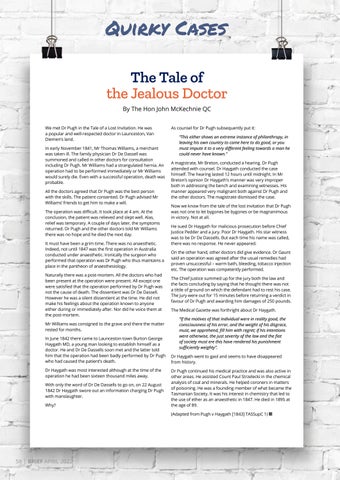The Tale of the Jealous Doctor By The Hon John McKechnie QC We met Dr Pugh in the Tale of a Lost Invitation. He was a popular and well-respected doctor in Launceston, Van Diemen’s land. In early November 1841, Mr Thomas Williams, a merchant was taken ill. The family physician Dr De Dassell was summoned and called in other doctors for consultation including Dr Pugh. Mr Williams had a strangulated hernia. An operation had to be performed immediately or Mr Williams would surely die. Even with a successful operation, death was probable. All the doctors agreed that Dr Pugh was the best person with the skills. The patient consented. Dr Pugh advised Mr Williams’ friends to get him to make a will. The operation was difficult. It took place at 4 am. At the conclusion, the patient was relieved and slept well. Alas, relief was temporary. A couple of days later, the symptoms returned. Dr Pugh and the other doctors told Mr Williams there was no hope and he died the next day. It must have been a grim time. There was no anaesthetic. Indeed, not until 1847 was the first operation in Australia conducted under anaesthetic. Ironically the surgeon who performed that operation was Dr Pugh who thus maintains a place in the pantheon of anaesthesiology. Naturally there was a post-mortem. All the doctors who had been present at the operation were present. All except one were satisfied that the operation performed by Dr Pugh was not the cause of death. The dissentient was Dr De Dassell. However he was a silent dissentient at the time. He did not make his feelings about the operation known to anyone either during or immediately after. Nor did he voice them at the post-mortem. Mr Williams was consigned to the grave and there the matter rested for months. In June 1842 there came to Launceston town Burton George Haygath MD, a young man looking to establish himself as a doctor. He and Dr De Dassells soon met and the latter told him that the operation had been badly performed by Dr Pugh who had caused the patient’s death. Dr Haygath was most interested although at the time of the operation he had been sixteen thousand miles away. With only the word of Dr De Dassells to go on, on 22 August 1842 Dr Haygath swore out an information charging Dr Pugh with manslaughter. Why?
As counsel for Dr Pugh subsequently put it: “This either shows an extreme instance of philanthropy, in leaving his own country to come here to do good, or you must impute it to a very different feeling towards a man he could never have known.” A magistrate, Mr Breton, conducted a hearing. Dr Pugh attended with counsel. Dr Haygath conducted the case himself. The hearing lasted 12 hours until midnight. In Mr Breton’s opinion Dr Haygath’s manner was very improper both in addressing the bench and examining witnesses. His manner appeared very malignant both against Dr Pugh and the other doctors. The magistrate dismissed the case. Now we know from the tale of the lost invitation that Dr Pugh was not one to let bygones be bygones or be magnanimous in victory. Not at all. He sued Dr Haygath for malicious prosecution before Chief Justice Pedder and a jury. Poor Dr Haygath. His star witness was to be Dr De Dassells. But each time his name was called, there was no response. He never appeared. On the other hand, other doctors did give evidence. Dr Gaunt said an operation was agreed after the usual remedies had proven unsuccessful – warm bath, bleeding, tobacco injection etc. The operation was competently performed. The Chief Justice summed up for the jury both the law and the facts concluding by saying that he thought there was not a tittle of ground on which the defendant had to rest his case. The jury were out for 15 minutes before returning a verdict in favour of Dr Pugh and awarding him damages of 250 pounds. The Medical Gazette was forthright about Dr Haygath. “If the motives of that individual were in reality good, the consciousness of his error, and the weight of his disgrace, must, we apprehend, fill him with regret; if his intentions were otherwise, the just severity of the law and the fiat of society must ere this have rendered his punishment sufficiently weighty”. Dr Haygath went to gaol and seems to have disappeared from history. Dr Pugh continued his medical practice and was also active in other areas. He assisted Count Paul Strzelecki in the chemical analysis of coal and minerals. He helped coroners in matters of poisoning. He was a founding member of what became the Tasmanian Society. It was his interest in chemistry that led to the use of ether as an anaesthetic in 1847. He died in 1895 at the age of 89. (Adapted from Pugh v Haygath [1843] TASSupC 1)
58 | BRIEF APRIL 2022
















